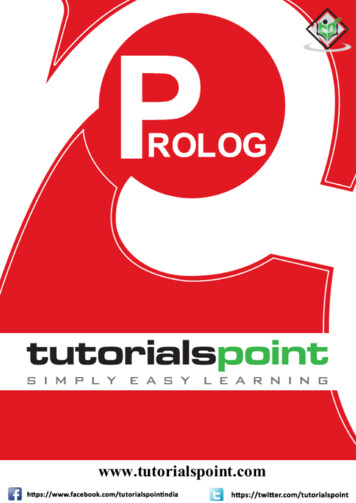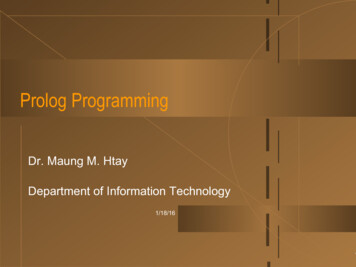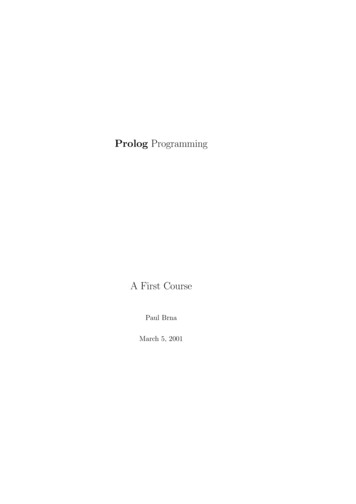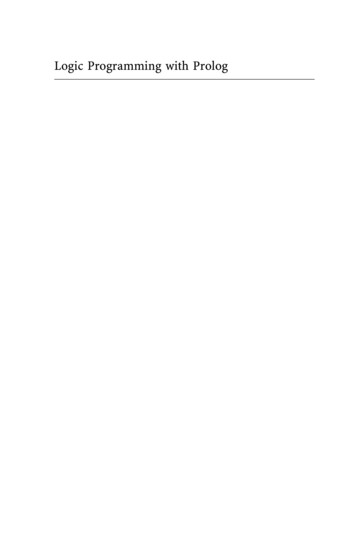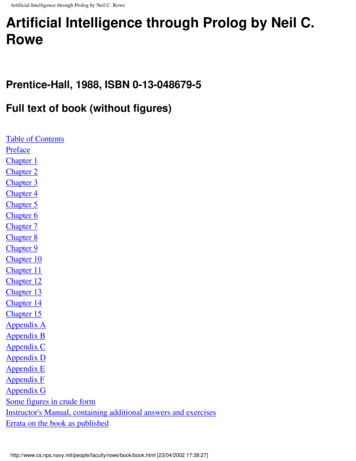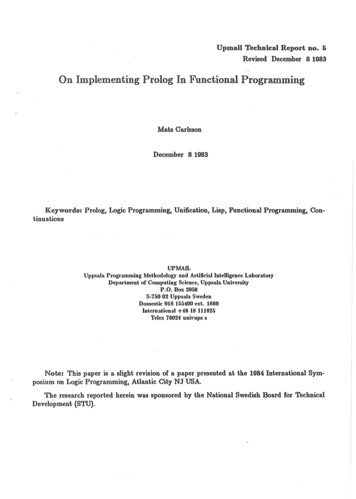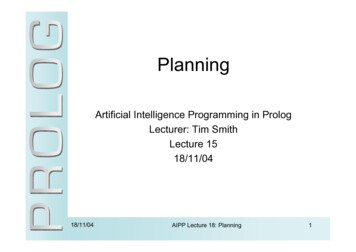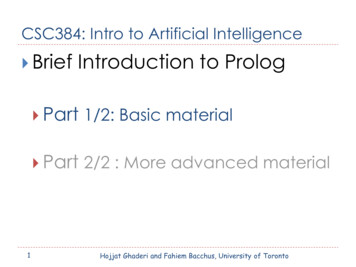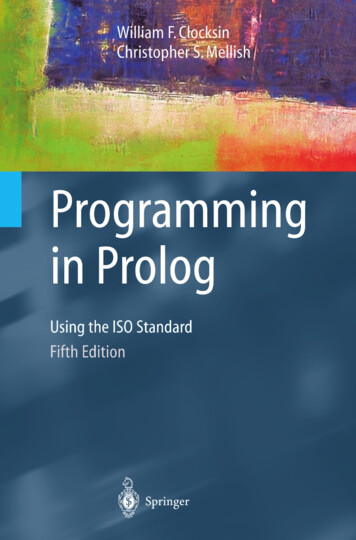
Transcription
Programming in Prolog
Springer-Verlag Berlin Heidelberg GmbH
W. F. Clocksin · C.S. MellishProgrammingin PrologFifth Edition123
Prof. William F. ClocksinOxford Brookes UniversityDepartment of ComputingWheatley CampusOxford OX33 1HX, United KingdomDr. Christopher S. MellishUniversity of EdinburghDepartment of Artificial Intelligence80 South BridgeEdinburgh EH1 1HN, United KingdomISBN 978-3-540-00678-7ISBN 978-3-642-55481-0 (eBook)DOI 10.1007/978-3-642-55481-0Cataloging-in-Publication Data applied forClocksin, W.F. (William F.), 1955Programming in Prolog: using the ISO standard/W.F. Clocksin, C.S. Mellish.--5th ed. p.cm.Includes bibliographical references and index.ISBN 978-3-540-00678-7 (alk.paper)1.Prolog (Computer program language) I.Mellish, C.S. (Christopher S.), 1954-II. Title.QA76.73.P76C57 2003005.13 3--dc21 2003044177This work is subject to copyright. All rights are reserved, whether the whole or part of the materialis concerned, specifically the rights of translation, reprinting, reuse of illustrations, recitation,broadcasting, reproduction on microfilm or in any other way, and storage in data banks. Duplicationof this publication or parts thereof is permitted only under the provisions of the German CopyrightLaw of September 9, 1965, in its current version, and permission for use must always be obtainedfrom Springer-Verlag. Violations are liable for prosecution under the German Copyright Law.http://www.springer.de Springer-Verlag Berlin Heidelberg 2003Originally published by Springer-Verlag Berlin Heidelberg New York in 2003The use of general descriptive names, registered names, trademarks, etc. in this publication does notimply, even in the absence of a specific statement, that such names are exempt from the relevantprotective laws and regulations and therefore free for general use.Printed on acid-free paper41/3111XO – 5 4 3 2 1
Preface to the Fifth EditionSince the previous edition of Programming in Prolog, the Prolog language hasbeen standardised by the International Organization for Standardization (ISO). Although not all Prolog systems conform to the new standard, we felt it was necessaryto take the opportunity to update this book in accordance with the standard. We havealso introduced some new material, clarified some explanations, corrected a numberof minor errors, and removed appendices about Prolog systems that are now obsolete.This book can serve several purposes. The aim of this book is not to teach theart of programming as such. We feel that programming cannot be learned simply byreading a book or by listening to a lecturer. You’ve got to do programming to learn it.We hope that beginners without a mathematical background can learn Prolog fromthis book, although in this case we would recommend that the beginner is taught bya programmer who knows Prolog, as part of a course that introduces the student toprogramming as such. It is assumed that beginners can obtain the use of a computerthat has a Prolog system installed, and that they have been instructed in the use ofthe computer. Experienced programmers should not require extra assistance, but wehope they will not be dismayed at our intention to restrain mathematical elaboration.In our experience, novice programmers find that Prolog programs seem to bemore comprehensible than equivalent programs in conventional languages. However,the same people tend not to appreciate the limitations that conventional languagesplace on their use of computing resources. On the other hand, programmers experienced in conventional languages are better prepared to deal with abstract conceptssuch as variables and control flow. But, in spite of this prior experience, they mayfind Prolog difficult to adapt to, and they may need a lot of convincing before theyconsider Prolog a useful programming tool. Of course, we know of many highly experienced programmers who have taken up Prolog with much enthusiasm. However,the aim of this book is not to convert, but to teach.Programming in Prolog can be a useful companion to two other books. Thebeginner might use Programming in Prolog as a tutorial preliminary to the more
VIPreface to the Fifth Editionconcise and advanced text Clause and Effect. The more experienced programmermight start with Clause and Effect and be writing useful programs within a few hours,returning to Programming in Prolog to fill in any gaps in understanding. Clause andEffect also conforms to ISO Standard Prolog, and it may be beneficial to use thereference manual Prolog: The Standard in conjunction with this book. Details ofthese books are:Clause and Effect, by W.F. Clocksin.Springer-Verlag, 1997. ISBN 3-540-62971-8.Prolog: The Standard, by P. Deransart, A. Ed-Dbali, and L. Cervoni.Springer-Verlag, 1996. ISBN 3-540-59304-7.Provided that the reader is equipped with a Prolog implementation that conforms tothe ISO standard, the book Prolog: The Standard almost obviates the need for animplementation-specific reference manual, although the latter would be useful fordocumenting implementation-defined parameters and limits.Like most other programming languages, Prolog exists in a number of different implementations, each with its own semantic and syntactic peculiarities. In thisbook we have adopted a core Prolog based on ISO Standard Prolog. Previous editions conformed to a de facto standard that became known as Edinburgh Prolog. Inturn, Edinburgh Prolog was the main influence on the specification of ISO StandardProlog. The table shown below summarises the main changes that have been madein the use of particular syntactic forms, special atoms and built-in predicates sinceearlier versions of this book in order to conform to the Standard or otherwise reflectmore recent practice. Most of the differences between the Edinburgh and ISO coreversions are of a purely cosmetic nature, though ISO Standard Prolog has gone innew directions in the way that input/output is handled.This book was designed to be read sequentially, although it will prove helpfulto read Chap. 8 when the reader begins to write Prolog programs consisting of morethan about ten clauses. It shouldn’t hurt to browse through the book, but do take carenot to skip over the earlier chapters.Each chapter is divided into several sections, and we advise the reader to attempt the exercises that are at the end of many sections. The solutions to some ofthe exercises appear at the end of the book. Chapter 1 is a tutorial introduction thatis intended to give the reader a feel for what is required to program in Prolog. Thefundamental ideas of Prolog are introduced, and the reader is advised to study themcarefully. Chapter 2 presents a more complete discussion of points that are introduced in Chapter 1. Chapter 3 deals with data structures and derives some smallexample programs. Chapter 4 treats the subject of backtracking in more detail, andintroduces the cut symbol, which is used to control backtracking. Chapter 5 intro-
Preface to the Fifth EditionEdinburgh Editions"." (string) notationASCII codes for charactersget, get0, putsee, seeing, seentell, telling, tolduserintegerreconsultnottab, skipdisplayassert/ arithmetic operatornameVIIISO EditionNot used (can mean different things)Single element atoms as charactersget char, put charopen, set input, current inputopen, set output, current outputuser input and user outputnumber (floating-point numbers are handled)consult (though not in the Standard)\ not usedwrite canonicalasserta, assertz/ and // operatorsatom chars, number chars@ , @ etc. introduced : and \ introducedTable of differences between previous editions, which used the Edinburgh Prolog standard,and the present edition, which uses the ISO standard.duces the facilities that are available for input and output. Chapter 6 describes eachbuilt-in predicate in the standard core of Prolog. Chapter 7 is a potpourri of exampleprograms collected from many sources, together with an explanation of how theyare written. Chapter 8 offers some advice on debugging Prolog programs. Chapter9 introduces the Grammar Rule syntax, and examines the design decisions for someaspects of analysing natural language by using Grammar Rules. Chapter 10 describesthe relation of Prolog to its origins in mathematical theorem proving and logic programming. Chapter 11 specifies a number of projects on which interested readersmay wish to practise their programming ability.During the past twenty years that previous editions of this book have been in use,individuals too numerous to list by name have given us help, support, encouragement, suggestions, and comments about this book. We are grateful to our readers,students, teachers, colleagues, correspondents, editors, friends and family who havecontributed in various and manifold ways. Of course, responsibility for the errors andomissions that remain in this edition rests entirely with us.Oxford and EdinburghJune 2003William ClocksinChris Mellish
Table of Contents1Tutorial Introduction . . . . . . . . . . . . . . . . . . . . . . . . . . . . . . . . . . . . . . . . . . .1Gives the student a feel for what it is like to program in Prolog.Introduces objects, relationships, facts, rules, variables1.11.21.31.41.51.61.71.81.92Prolog . . . . . . . . . . . . . . . . . . . . . . . . . . . . . . . . . . . . . . . . . . . . . . . . . . . .Objects and Relationships . . . . . . . . . . . . . . . . . . . . . . . . . . . . . . . . . . .Programming . . . . . . . . . . . . . . . . . . . . . . . . . . . . . . . . . . . . . . . . . . . . . .Facts . . . . . . . . . . . . . . . . . . . . . . . . . . . . . . . . . . . . . . . . . . . . . . . . . . . . .Questions . . . . . . . . . . . . . . . . . . . . . . . . . . . . . . . . . . . . . . . . . . . . . . . . .Variables . . . . . . . . . . . . . . . . . . . . . . . . . . . . . . . . . . . . . . . . . . . . . . . . . .Conjunctions . . . . . . . . . . . . . . . . . . . . . . . . . . . . . . . . . . . . . . . . . . . . . .Rules . . . . . . . . . . . . . . . . . . . . . . . . . . . . . . . . . . . . . . . . . . . . . . . . . . . . .Summary and Exercises . . . . . . . . . . . . . . . . . . . . . . . . . . . . . . . . . . . . .123468101622A Closer Look . . . . . . . . . . . . . . . . . . . . . . . . . . . . . . . . . . . . . . . . . . . . . . . . .25More detailed presentation of Prolog syntax and data structures2.1 Syntax . . . . . . . . . . . . . . . . . . . . . . . . . . . . . . . . . . . . . . . . . . . . . . . . . . . .2.1.1 Constants . . . . . . . . . . . . . . . . . . . . . . . . . . . . . . . . . . . . . . . . . . .2.1.2 Variables . . . . . . . . . . . . . . . . . . . . . . . . . . . . . . . . . . . . . . . . . . .2.1.3 Structures . . . . . . . . . . . . . . . . . . . . . . . . . . . . . . . . . . . . . . . . . .2.2 Characters . . . . . . . . . . . . . . . . . . . . . . . . . . . . . . . . . . . . . . . . . . . . . . . .2.3 Operators . . . . . . . . . . . . . . . . . . . . . . . . . . . . . . . . . . . . . . . . . . . . . . . . .2.4 Equality and Unification . . . . . . . . . . . . . . . . . . . . . . . . . . . . . . . . . . . . .2.5 Arithmetic . . . . . . . . . . . . . . . . . . . . . . . . . . . . . . . . . . . . . . . . . . . . . . . .2.6 Summary of Satisfying Goals . . . . . . . . . . . . . . . . . . . . . . . . . . . . . . . .2.6.1 Successful satisfaction of a conjunction of goals . . . . . . . . . .25262727293032343738
XTable of Contents2.6.22.6.33Consideration of goals in backtracking . . . . . . . . . . . . . . . . . .Unification . . . . . . . . . . . . . . . . . . . . . . . . . . . . . . . . . . . . . . . . . .4243Using Data Structures . . . . . . . . . . . . . . . . . . . . . . . . . . . . . . . . . . . . . . . . . .47Representing objects and relationships by using trees and lists.Developing several standard Prolog programming techniques3.13.23.33.43.53.63.73.84Structures and Trees . . . . . . . . . . . . . . . . . . . . . . . . . . . . . . . . . . . . . . . .Lists . . . . . . . . . . . . . . . . . . . . . . . . . . . . . . . . . . . . . . . . . . . . . . . . . . . . .Recursive Search . . . . . . . . . . . . . . . . . . . . . . . . . . . . . . . . . . . . . . . . . . .Mapping . . . . . . . . . . . . . . . . . . . . . . . . . . . . . . . . . . . . . . . . . . . . . . . . . .Recursive Comparison . . . . . . . . . . . . . . . . . . . . . . . . . . . . . . . . . . . . . .Joining Structures Together . . . . . . . . . . . . . . . . . . . . . . . . . . . . . . . . . .Accumulators . . . . . . . . . . . . . . . . . . . . . . . . . . . . . . . . . . . . . . . . . . . . . .Difference Structures . . . . . . . . . . . . . . . . . . . . . . . . . . . . . . . . . . . . . . .4750535760636770Backtracking and the “Cut” . . . . . . . . . . . . . . . . . . . . . . . . . . . . . . . . . . . . .73How a set of clauses generates a set of solutions. Using “cut” to modifythe control sequence of running Prolog programs54.1 Generating Multiple Solutions . . . . . . . . . . . . . . . . . . . . . . . . . . . . . . . .4.2 The “Cut” . . . . . . . . . . . . . . . . . . . . . . . . . . . . . . . . . . . . . . . . . . . . . . . . .4.3 Common Uses of the Cut . . . . . . . . . . . . . . . . . . . . . . . . . . . . . . . . . . . .4.3.1 Confirming the Choice of a Rule . . . . . . . . . . . . . . . . . . . . . . .4.3.2 The “cut-fail” Combination . . . . . . . . . . . . . . . . . . . . . . . . . . . .4.3.3 Terminating a “generate and test” . . . . . . . . . . . . . . . . . . . . . . .4.4 Problems with the Cut . . . . . . . . . . . . . . . . . . . . . . . . . . . . . . . . . . . . . .74808585909296Input and Output . . . . . . . . . . . . . . . . . . . . . . . . . . . . . . . . . . . . . . . . . . . . . .99Facilities available for the input and output of characters and structures.Developing a program to read sentences from the user and representthe structure as a list of words, which can be used with the Grammar Rulesof Chapter 95.1 Reading and Writing Terms . . . . . . . . . . . . . . . . . . . . . . . . . . . . . . . . . .5.1.1 Reading Terms . . . . . . . . . . . . . . . . . . . . . . . . . . . . . . . . . . . . . .5.1.2 Writing Terms . . . . . . . . . . . . . . . . . . . . . . . . . . . . . . . . . . . . . . .5.2 Reading and Writing Characters . . . . . . . . . . . . . . . . . . . . . . . . . . . . . .5.2.1 Reading Characters . . . . . . . . . . . . . . . . . . . . . . . . . . . . . . . . . .5.2.2 Writing Characters . . . . . . . . . . . . . . . . . . . . . . . . . . . . . . . . . . .100100101104105106
Table of Contents5.3 Reading English Sentences . . . . . . . . . . . . . . . . . . . . . . . . . . . . . . . . . .5.4 Reading and Writing Files . . . . . . . . . . . . . . . . . . . . . . . . . . . . . . . . . . .5.4.1 Opening and closing streams . . . . . . . . . . . . . . . . . . . . . . . . . . .5.4.2 Changing the current input and output . . . . . . . . . . . . . . . . . . .5.4.3 Consulting . . . . . . . . . . . . . . . . . . . . . . . . . . . . . . . . . . . . . . . . . .5.5 Declaring Operators . . . . . . . . . . . . . . . . . . . . . . . . . . . . . . . . . . . . . . . .6XI108111112113115116Built-in Predicates . . . . . . . . . . . . . . . . . . . . . . . . . . . . . . . . . . . . . . . . . . . . . 119Definition of the “core” built-in predicates, with sensible examplesof how each one is used. By this point, the reader should be ableto read reasonably complex programs, and should therefore be ableto absorb the built-in predicates by seeing them in ering New Clauses . . . . . . . . . . . . . . . . . . . . . . . . . . . . . . . . . . . . . . .Success and Failure . . . . . . . . . . . . . . . . . . . . . . . . . . . . . . . . . . . . . . . . .Classifying Terms . . . . . . . . . . . . . . . . . . . . . . . . . . . . . . . . . . . . . . . . . .Treating Clauses as Terms . . . . . . . . . . . . . . . . . . . . . . . . . . . . . . . . . . .Constructing and Accessing Components of Structures . . . . . . . . . . .Affecting Backtracking . . . . . . . . . . . . . . . . . . . . . . . . . . . . . . . . . . . . . .Constructing Compound Goals . . . . . . . . . . . . . . . . . . . . . . . . . . . . . . .Equality . . . . . . . . . . . . . . . . . . . . . . . . . . . . . . . . . . . . . . . . . . . . . . . . . .Input and Output . . . . . . . . . . . . . . . . . . . . . . . . . . . . . . . . . . . . . . . . . . .Handling Files . . . . . . . . . . . . . . . . . . . . . . . . . . . . . . . . . . . . . . . . . . . . .Evaluating Arithmetic Expressions . . . . . . . . . . . . . . . . . . . . . . . . . . .Comparing Terms . . . . . . . . . . . . . . . . . . . . . . . . . . . . . . . . . . . . . . . . . .Watching Prolog at Work . . . . . . . . . . . . . . . . . . . . . . . . . . . . . . . . . . . .120121122123127132134136137138139140143More Example Programs . . . . . . . . . . . . . . . . . . . . . . . . . . . . . . . . . . . . . . . 145Many example programs are given, covering a wide range of interests.Examples include list processing, set operations, symbolic differentiationand simplification of formulæ7.17.27.37.47.57.67.77.8A Sorted Tree Dictionary . . . . . . . . . . . . . . . . . . . . . . . . . . . . . . . . . . . .Searching a Maze . . . . . . . . . . . . . . . . . . . . . . . . . . . . . . . . . . . . . . . . . .The Towers of Hanoi . . . . . . . . . . . . . . . . . . . . . . . . . . . . . . . . . . . . . . . .Parts Inventory . . . . . . . . . . . . . . . . . . . . . . . . . . . . . . . . . . . . . . . . . . . . .List Processing . . . . . . . . . . . . . . . . . . . . . . . . . . . . . . . . . . . . . . . . . . . .Representing and Manipulating Sets . . . . . . . . . . . . . . . . . . . . . . . . . . .Sorting . . . . . . . . . . . . . . . . . . . . . . . . . . . . . . . . . . . . . . . . . . . . . . . . . . .Using the Database . . . . . . . . . . . . . . . . . . . . . . . . . . . . . . . . . . . . . . . . .145148152153155159161164
XIITable of Contents7.97.107.117.127.137.1487.8.1 Random . . . . . . . . . . . . . . . . . . . . . . . . . . . . . . . . . . . . . . . . . . . .7.8.2 Gensym . . . . . . . . . . . . . . . . . . . . . . . . . . . . . . . . . . . . . . . . . . . .7.8.3 Findall . . . . . . . . . . . . . . . . . . . . . . . . . . . . . . . . . . . . . . . . . . . . .Searching Graphs . . . . . . . . . . . . . . . . . . . . . . . . . . . . . . . . . . . . . . . . . .Sift the Two’s and Sift the Three’s . . . . . . . . . . . . . . . . . . . . . . . . . . . . .Symbolic Differentiation . . . . . . . . . . . . . . . . . . . . . . . . . . . . . . . . . . . .Mapping Structures and Transforming Trees . . . . . . . . . . . . . . . . . . . .Manipulating Programs . . . . . . . . . . . . . . . . . . . . . . . . . . . . . . . . . . . . .Bibliographic Notes . . . . . . . . . . . . . . . . . . . . . . . . . . . . . . . . . . . . . . . .164165167169174177179182185Debugging Prolog Programs . . . . . . . . . . . . . . . . . . . . . . . . . . . . . . . . . . . . . 187By this point, the reader will be able to write reasonable programs,and so the problem of debugging will be relevant. Flow of control model,hints about common bugs, techniques of debugging.8.18.28.38.4Laying out Programs . . . . . . . . . . . . . . . . . . . . . . . . . . . . . . . . . . . . . . . .Common Errors . . . . . . . . . . . . . . . . . . . . . . . . . . . . . . . . . . . . . . . . . . . .The Tracing Model . . . . . . . . . . . . . . . . . . . . . . . . . . . . . . . . . . . . . . . . .Tracing and Spy Points . . . . . . . . . . . . . . . . . . . . . . . . . . . . . . . . . . . . . .8.4.1 Examining the Goal . . . . . . . . . . . . . . . . . . . . . . . . . . . . . . . . . .8.4.2 Examining the Ancestors . . . . . . . . . . . . . . . . . . . . . . . . . . . . . .8.4.3 Altering the Degree of Tracing . . . . . . . . . . . . . . . . . . . . . . . . .8.4.4 Altering the Satisfaction of the Goal . . . . . . . . . . . . . . . . . . . .8.4.5 Other Options . . . . . . . . . . . . . . . . . . . . . . . . . . . . . . . . . . . . . . .8.4.6 Summary . . . . . . . . . . . . . . . . . . . . . . . . . . . . . . . . . . . . . . . . . . .8.5 Fixing Bugs . . . . . . . . . . . . . . . . . . . . . . . . . . . . . . . . . . . . . . . . . . . . . . .9188191194200204205206207209209210Using Prolog Grammar Rules . . . . . . . . . . . . . . . . . . . . . . . . . . . . . . . . . . . 213Applications of existing techniques. Using Grammar Rules.Examining the design decisions for some aspects of analysing naturallanguage with Grammar Rules9.19.29.39.49.59.69.79.8The Parsing Problem . . . . . . . . . . . . . . . . . . . . . . . . . . . . . . . . . . . . . . . .Representing the Parsing Problem in Prolog . . . . . . . . . . . . . . . . . . . .The Grammar Rule Notation . . . . . . . . . . . . . . . . . . . . . . . . . . . . . . . . .Adding Extra Arguments . . . . . . . . . . . . . . . . . . . . . . . . . . . . . . . . . . . .Adding Extra Tests . . . . . . . . . . . . . . . . . . . . . . . . . . . . . . . . . . . . . . . . .Summary . . . . . . . . . . . . . . . . . . . . . . . . . . . . . . . . . . . . . . . . . . . . . . . . .Translating Language into Logic . . . . . . . . . . . . . . . . . . . . . . . . . . . . . .More General Use of Grammar Rules . . . . . . . . . . . . . . . . . . . . . . . . . .213216221223227230231233
Table of ContentsXIII10 The Relation of Prolog to Logic . . . . . . . . . . . . . . . . . . . . . . . . . . . . . . . . . . 237Predicate Calculus, clausal form, resolution theorem proving, logic programming10.110.210.310.410.510.610.7Brief Introduction to Predicate Calculus . . . . . . . . . . . . . . . . . . . . . . . .Clausal Form . . . . . . . . . . . . . . . . . . . . . . . . . . . . . . . . . . . . . . . . . . . . . .A Notation for Clauses . . . . . . . . . . . . . . . . . . . . . . . . . . . . . . . . . . . . . .Resolution and Proving Theorems . . . . . . . . . . . . . . . . . . . . . . . . . . . . .Horn Clauses . . . . . . . . . . . . . . . . . . . . . . . . . . . . . . . . . . . . . . . . . . . . . .Prolog . . . . . . . . . . . . . . . . . . . . . . . . . . . . . . . . . . . . . . . . . . . . . . . . . . . .Prolog and Logic Programming . . . . . . . . . . . . . . . . . . . . . . . . . . . . . . .23724024624825125225411 Projects in Prolog . . . . . . . . . . . . . . . . . . . . . . . . . . . . . . . . . . . . . . . . . . . . . . 259A selection of suggested exercises, projects and problems11.1 Easier Projects . . . . . . . . . . . . . . . . . . . . . . . . . . . . . . . . . . . . . . . . . . . . . 25911.2 Advanced Projects . . . . . . . . . . . . . . . . . . . . . . . . . . . . . . . . . . . . . . . . . . 262AAnswers to Selected Exercises . . . . . . . . . . . . . . . . . . . . . . . . . . . . . . . . . . . 267BClausal Form Program Listings . . . . . . . . . . . . . . . . . . . . . . . . . . . . . . . . . . 271CWriting Portable Standard Prolog Programs . . . . . . . . . . . . . . . . . . . . . . 277The Prolog standard, writing portable programs and dealing with differentProlog implementationsC.1C.2C.3C.4DStandard Prolog for Portability . . . . . . . . . . . . . . . . . . . . . . . . . . . . . . .Different Prolog Implementations . . . . . . . . . . . . . . . . . . . . . . . . . . . . .Issues to Look Out For . . . . . . . . . . . . . . . . . . . . . . . . . . . . . . . . . . . . . .Definitions of some Standard Predicates . . . . . . . . . . . . . . . . . . . . . . . .C.4.1 Character Processing . . . . . . . . . . . . . . . . . . . . . . . . . . . . . . . . .C.4.2 Directives . . . . . . . . . . . . . . . . . . . . . . . . . . . . . . . . . . . . . . . . . .C.4.3 Stream Input/Output . . . . . . . . . . . . . . . . . . . . . . . . . . . . . . . . . .C.4.4 Miscellaneous . . . . . . . . . . . . . . . . . . . . . . . . . . . . . . . . . . . . . . .277278279280281283284287Code to Support DCGs . . . . . . . . . . . . . . . . . . . . . . . . . . . . . . . . . . . . . . . . . 289D.1 DCG Support Code . . . . . . . . . . . . . . . . . . . . . . . . . . . . . . . . . . . . . . . . . 290Index . . . . . . . . . . . . . . . . . . . . . . . . . . . . . . . . . . . . . . . . . . . . . . . . . . . . . . . . . . . . . 295
1Tutorial Introduction1.1 PrologProlog is a computer programming language. Since its beginnings around 1970, Prolog has been chosen by many programmers for applications of symbolic computation, including:relational databasesmathematical logicabstract problem solvingunderstanding natural languagedesign automationsymbolic equation solvingbiochemical structure analysismany areas of artificial intelligenceNewcomers to Prolog find that the task of writing a Prolog program is not like specifying an algorithm in the same way as in a conventional programming language.Instead, the Prolog programmer asks more about which formal relationships and objects occur in the problem, and which relationships are “true” about the desired solution. So, Prolog can be viewed as a descriptive language as well as a prescriptive one.The Prolog approach is more about describing known facts and relationships abouta problem, and less about prescribing the sequence of steps taken by a computer tosolve the problem. When a computer is programmed in Prolog, the actual way thecomputer carries out the computation is specified partly by the logical declarative se-
2Chapter 1Tutorial Introductionmantics of Prolog, partly by what new facts Prolog can “infer” from the given ones,and only partly by explicit control information supplied by the programmer.1.2 Objects and RelationshipsProlog is a computer programming language that is used for solving problemsthat involve objects and the relationships between objects. When we say “John ownsthe book”, we are declaring that a relationship, ownership, exists between one object“John” and another individual object “the book”. Furthermore, the relationship hasa specific order: John owns the book, but the book doesn’t own John! When we askthe question, “Does John own the book?” we are trying to find out about a relationship. Many problems can be expressed by specifying objects and their relationships.Solving the problem amounts to asking the computer to find out about objects andrelationships that can be derived from our program.Some relationships don’t always mention all the objects that are involved. Forexample, when we say “The jewel is valuable”, we are specifying a relationship,called “being valuable”, which involves a jewel. We did not mention who finds thejewel valuable, or why. It all depends on what you want to say. In Prolog, whenyou will be programming the computer about relationships like these, the amount ofdetail you provide also depends on what you want the computer to accomplish.This way of talking about objects should not be confused with another popularprogramming methodology called object-oriented programming. In object-orientedprogramming, an object is a data structure that can inherit fields and executable methods from a class hierarchy to which the object belongs. Although the origin of objectoriented programming can be traced back to the middle 1960s, it became popular inthe 1980s and 1990s with the introduction of Smalltalk-80, C , and Java, amongother languages.By contrast, Prolog developed along an independent track from the early 1970s,and was inspired by logic programming research. Prolog should not be comparedwith object-oriented languages such as C and Java, because Prolog does a completely different job, and uses the word “object” in a completely different way. Prolog’s flexibility means that it is possible to write a Prolog program that interprets aProlog-like object-oriented language, but that is a different matter. So in Prolog, theword “object” does not refer to a data structure that can inherit variables and methodsfrom a class, but it refers to things that we can represent using terms.Prolog is a practical and efficient implementation of many aspects of “intelligent” program execution, such as non-determinism, parallelism, and pattern-directedprocedure call. Prolog provides a uniform data structure, called the term, from whichall data, as well as Prolog programs, are constructed. A Prolog program consists ofa set of clauses, where each clause is either a fact about the given information or a
1.3 Programming3rule about how the solution may relate to or be inferred from the given facts. Thus,Prolog can be seen as a first step towards the ultimate goal of programming in logic.In this book we shall not be concerned greatly with the wider implications of logicprogramming nor with why Prolog is not the ultimate logic programming language.Instead, we will be concerned with showing how useful programs can be writtenusing the Standard Prolog systems that exist today.There is one more point of philosophy to mention, then we shall begin programming. We are all familiar with using rules to describe relationships between objects.For example, the rule, “Two people are sisters if they are both female and have thesame parents” tells us something about what it means to be sisters. It also tells ushow to find out if two people are sisters: simply check to see if they are both femaleand have the same parents. What is important to notice about rules is that they areusually oversimplified, but they are acceptable as definitions. After all, one cannotexpect a definition to tell us everything about something.For example, most people would agree there is much more to “being sisters”in real life than the above rule implies. However, when we are solving a particularproblem, we need to concentrate on just those rules that help to solve the problem.So, we ought to consider an imaginary and simplified definition if it is sufficient forour purposes.1.3 ProgrammingIn this chapter we shall show the essential elements of the Prolog in real programs, but without becoming diverted by details, formal rules, and exceptions. Atthis point, we are not trying to be complete or precise. We want to bring
Department of Artificial Intelligence 80 South Bridge Edinburgh EH1 1HN,United Kingdom Cataloging-in-Publication Data applied for Clocksin, W.F .(William F.), 1955 - Programming in Prolog: using the ISO standard/W.F. Clocksin, C.S. Mellish.--5th ed. p.cm. Includes bibliographical
